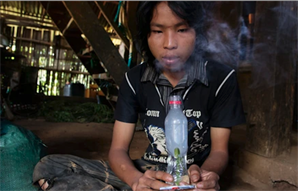Meth Use Is on the Rise in Southeast Asia – And COVID Is To Blame
An excess of drugs in the Golden Triangle region due to COVID export restrictions has led to an increase in meth use among young people and workers.
29 Jan 2021A COVID-19 bottleneck has led to Golden Triangle meth supplies leaking out into the region to fuel a rise in use among young people.

Behind the constant flow of highly publicised, sometimes record-breakingmeth seizures in Southeast Asia – featuring proud anti-drug cops and handcuffed smugglers standing around tables laden with cellophane-wrapped packages – little is known about how the trade is impacting local people.
Normally, much of the meth produced in the Golden Triangle – a global drug making hub in a remote jungle area where Myanmar, Laos and Thailand meet – is smuggled out to lucrative drug markets as far away as Australia and Japan, where the price of a kilo rises 100-fold.
But, according to the UN’s expert in the region, COVID-19 border restrictions have led to an abundance of meth exports staying in the area. This has in turn fuelled a rise in use of the stimulant drug by young people and workers and rising addiction – and more people entering the region’s outdated and harsh drug treatment regimes.
“During COVID, border closures, fewer flights and ways to move has meant there has been a shortage of meth coming out of the Golden Triangle and Southeast Asia, and we’ve seen price spikes in countries such as Australia where demand is high,” Jeremy Douglas, the regional representative of the UN Office of Drugs and Crime (UNODC) told VICE World News. “The messed up logistics has led to oversupply in the region itself. It's not getting out as it would normally and we are seeing a concentration of meth in the Mekong and surrounding countries.”
Share this on: